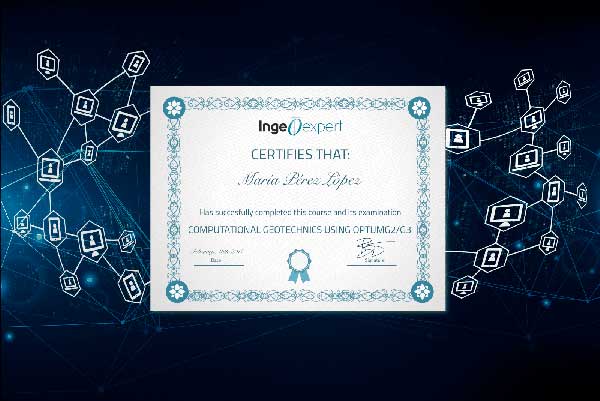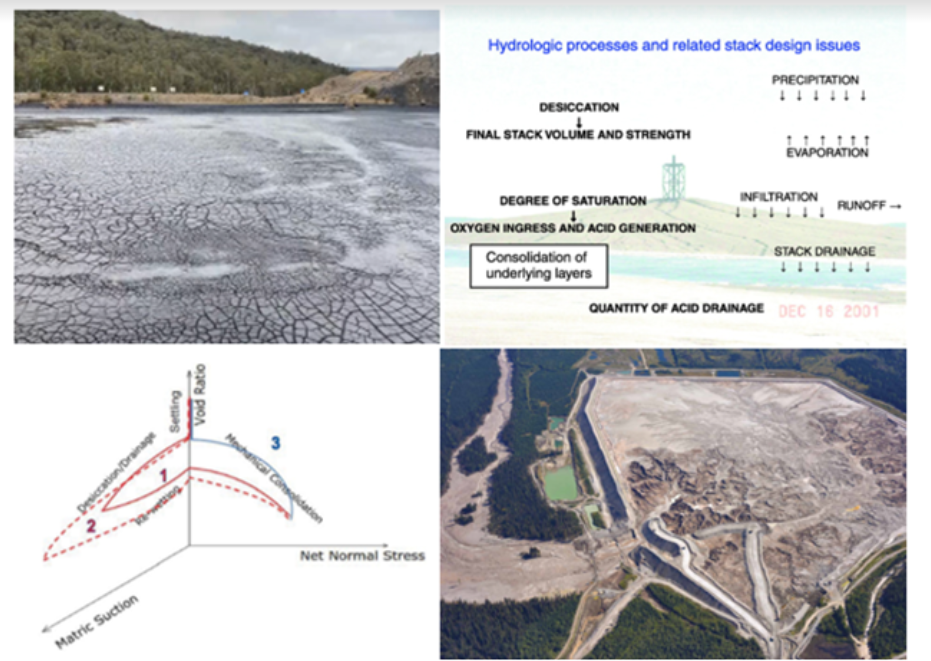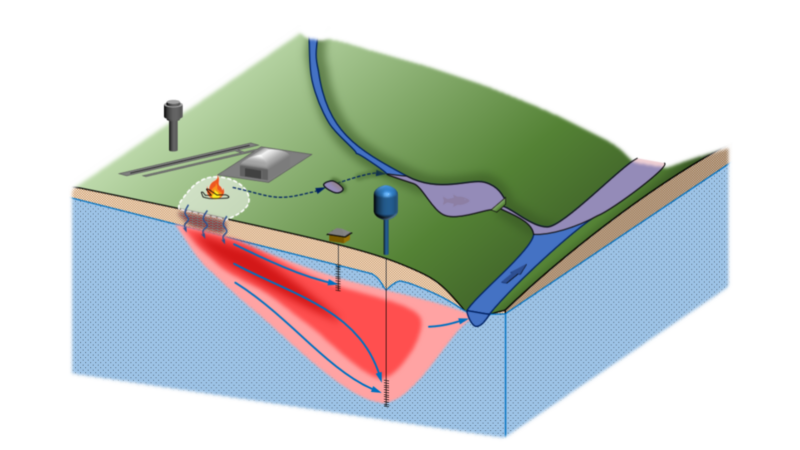In collaboration with GroundwaterU
Introduction
Groundwater makes up 99% of the Earth’s liquid freshwater, 2.5 billion people use groundwater as the sole source of freshwater, and it is the primary source of water for irrigation. Groundwater pollution is one of the primary factors that is exacerbating freshwater availability, not just in developing countries, but also in wealthy countries with ample infrastructure. Applied Contaminant Hydrogeology includes an understanding of the fundamental principles of groundwater pollution as well as real-world technical skills needed to identify and assess risks associated with groundwater contamination. Applied Contaminant Hydrogeology is for scientists, engineers, water law and policy professionals, and environmental sustainability planners.
This course provides students with an understanding of the fundamental principles and also techniques needed to evaluate how contaminants (a.k.a. environmental pollutants) enter the subsurface, migrate in groundwater, and ultimately impact our water resources. Students will become literate in assessing risk to drinking water, irrigation water and streams. Importantly, students who complete this class will gain new technical skills that can be immediately used as part of their professional development and repertoire of capabilities.
Skills can be applied directly to assess potential or known contaminant scenarios, assess risk, and help determine the sources of contamination and its potential future impact. This course is aimed at students and professionals with an engineering, geosciences, and/or environmental science background.
This course uses illustrations, animations, and various multimedia to facilitate learning. Live webinars accompany recorded video lecture material so students can ask questions and interactively review and clarify instructional material and, very importantly, review module exercises. Live webinars will be recorded for those who are unable to attend.
Objectives
In this class you will learn the fundamentals of groundwater flow, chemical transport in soil and groundwater, and how to assess the extent and impacts of groundwater contamination. These analyses form a basis for risk assessment and remedial selection. Theory will be combined with problem sets based on real field data and case studies.
This course is not just a theory and overview course; by the end of the course students will be equipped with new technical skills in groundwater data evaluation that can be applied to professional projects immediately.
At the conclusion of the course, students will be able to:
- Describe the issues related to groundwater contamination, the different types of contamination, how contaminants enter and migrate in groundwater and how the contaminated groundwater can pose a risk to human health and the environment.
- Interpret figures, maps, and graphs associated with groundwater contamination.
- Interpret field data and construct maps that depict the extent of groundwater contamination, how the contaminants will flow, and their ultimate impact on environmental receptors.
- Use simple models of groundwater fate and transport as predictive tools and as a tool to aid learning.
- Apply their new knowledge and technical skills to projects and elevate their professional standing.
This course will cover integration of field and laboratory data, together with qualitative and quantitative descriptions of contaminant transport, which form a basis of risk assessment and the selection/design of remediation technologies and groundwater law and governance issues. That is, practitioners in the field of water policy will be able to make more informed policy strategies and decisions.
Limited places.
Module 1. Fundamentals
- Course introduction, teaching approach, syllabus, goals, and expectations
- Visualization of groundwater flow and contamination using laboratory experiments, animations, maps, and illustrations
- Contaminant types, including petroleum hydrocarbons, solvents, and emerging contaminants such as per fluorinated and polyfluorinated alkyl substances (PFAS)
- Conceptual models
- Practice problems
Module 2. Principles of Groundwater Flow
- Hydraulic head
- Potentiometric gradient, contours, and flow direction
- Hydrogeologic properties of soil and rocks
- Groundwater velocity
- Practice problems from “Conceptual and Visual Understanding of Hydraulic Head and Groundwater Flow”, Cohen and Cherry, 2020. https://gw-project.org/books/conceptual-and-visual-understanding-of-hydraulic-head-and-groundwater-flow/
Module 3. Interpreting and Creating Groundwater Flow Maps
Interpreting water level measurement data and creating maps that correctly depict the direction of groundwater flow is the most important skill for assessing groundwater contamination. This module addresses:
- Measurement of groundwater elevations
- Construction of potentiometric contour and groundwater flow maps
- Case studies and practice problems
Module 4. Contaminant Fate & transport processes
- Dissolution, advection, dispersion, degradation, sorption, and vaporization
- Use of spreadsheet-based models for data evaluation and prediction
- Case studies and practice problems
Module 5. Simulation of Groundwater Flow and Contamination
- Use of open-source models as learning tools and to predict groundwater contamination
- Case studies and practice problems
Module 6. Creating contaminant plume maps
- Construction of groundwater plume maps and cross sections based on groundwater concentration data.
- Case studies and practice problems
Andrew Cohen
Dr. Andrew Cohen received his Ph.D. in Civil and Environmental Engineering from the University of California at Berkeley and a B.S. in Water Resources from the Department of Earth Sciences, State University of New York at Oneonta. His focus is hydrogeologic characterization of contaminated sites and related modeling of transport and fate of contaminants in soil, groundwater, surface water, and sediment. Prior to his current role as a contaminant hydrogeologist in the environmental consulting industry, he was a Research Associate at Lawrence Berkeley National Laboratory, where he focused on characterization and modeling of groundwater in fractured and faulted bedrock. Dr. Cohen is the founder of GroundwaterU, an open-source groundwater educational platform (groundwateru.org), co-author (with John A. Cherry) of “Conceptual and Visual Understanding of Hydraulic Head and Groundwater Flow”, and he is Adjunct Professor at the New Jersey Institute of Technology, where he teaches Contaminant Hydrogeology.
The course is delivered online through our easy-to-use Virtual Campus platform. For this course, a variety of content is provided including:
– eLearning materials
– Videos
– Interactive multimedia content
– Live webinar classes
– Texts and technical articles
– Case studies
– Assignments and evaluation exercises
Students can download the materials and work through the course at their own pace.
We regularly update this course to ensure the latest news and state-of-the-art developments are covered, and your knowledge of the subject is current.
Live webinars form part of our course delivery. These allow students and tutors to go through the course materials, exchange ideas and knowledge, and solve problems together in a virtual classroom setting. Students can also make use of the platform’s forum, a meeting point to interact with tutors and other students.
The tutoring system is managed by email. Students can email the tutor with any questions about the course and the tutor will be happy to help.
This course is ideal for practitioners in environmental engineering, consulting, and environmental policy who want to sharpen their knowledge base and develop applicable skills to benefit clients and project stakeholders, and to further their professional development.
Once a student finishes the course and successfully completes the assignments and evaluation tests, they are sent an accreditation certificate. The certificate is issued by Ingeoexpert to verify that the student has passed the course. It is a digital certificate that is unique and tamper-proof – it is protected by Blockchain technology. This means it is possible for anyone to check that it is an authentic, original document.
You will be able to download the certificate in an electronic format from the Virtual Campus platform. The certificate can be forwarded by email, shared on social networks, and embedded on websites. To see an example, click here.
Training provided in this course can complement previous academic training and work experience for entry level consultants, regulators, and industry professionals. Careers in the environmental industry, water resources exploration and development, and water resources management could be advanced with skills obtained in the Applied Contaminant Hydrogeology coursework.
In collaboration with GroundwaterU
Introduction
Groundwater makes up 99% of the Earth’s liquid freshwater, 2.5 billion people use groundwater as the sole source of freshwater, and it is the primary source of water for irrigation. Groundwater pollution is one of the primary factors that is exacerbating freshwater availability, not just in developing countries, but also in wealthy countries with ample infrastructure. Applied Contaminant Hydrogeology includes an understanding of the fundamental principles of groundwater pollution as well as real-world technical skills needed to identify and assess risks associated with groundwater contamination. Applied Contaminant Hydrogeology is for scientists, engineers, water law and policy professionals, and environmental sustainability planners.
This course provides students with an understanding of the fundamental principles and also techniques needed to evaluate how contaminants (a.k.a. environmental pollutants) enter the subsurface, migrate in groundwater, and ultimately impact our water resources. Students will become literate in assessing risk to drinking water, irrigation water and streams. Importantly, students who complete this class will gain new technical skills that can be immediately used as part of their professional development and repertoire of capabilities.
Skills can be applied directly to assess potential or known contaminant scenarios, assess risk, and help determine the sources of contamination and its potential future impact. This course is aimed at students and professionals with an engineering, geosciences, and/or environmental science background.
This course uses illustrations, animations, and various multimedia to facilitate learning. Live webinars accompany recorded video lecture material so students can ask questions and interactively review and clarify instructional material and, very importantly, review module exercises. Live webinars will be recorded for those who are unable to attend.
Objectives
In this class you will learn the fundamentals of groundwater flow, chemical transport in soil and groundwater, and how to assess the extent and impacts of groundwater contamination. These analyses form a basis for risk assessment and remedial selection. Theory will be combined with problem sets based on real field data and case studies.
This course is not just a theory and overview course; by the end of the course students will be equipped with new technical skills in groundwater data evaluation that can be applied to professional projects immediately.
At the conclusion of the course, students will be able to:
- Describe the issues related to groundwater contamination, the different types of contamination, how contaminants enter and migrate in groundwater and how the contaminated groundwater can pose a risk to human health and the environment.
- Interpret figures, maps, and graphs associated with groundwater contamination.
- Interpret field data and construct maps that depict the extent of groundwater contamination, how the contaminants will flow, and their ultimate impact on environmental receptors.
- Use simple models of groundwater fate and transport as predictive tools and as a tool to aid learning.
- Apply their new knowledge and technical skills to projects and elevate their professional standing.
This course will cover integration of field and laboratory data, together with qualitative and quantitative descriptions of contaminant transport, which form a basis of risk assessment and the selection/design of remediation technologies and groundwater law and governance issues. That is, practitioners in the field of water policy will be able to make more informed policy strategies and decisions.
Limited places.
Module 1. Fundamentals
- Course introduction, teaching approach, syllabus, goals, and expectations
- Visualization of groundwater flow and contamination using laboratory experiments, animations, maps, and illustrations
- Contaminant types, including petroleum hydrocarbons, solvents, and emerging contaminants such as per fluorinated and polyfluorinated alkyl substances (PFAS)
- Conceptual models
- Practice problems
Module 2. Principles of Groundwater Flow
- Hydraulic head
- Potentiometric gradient, contours, and flow direction
- Hydrogeologic properties of soil and rocks
- Groundwater velocity
- Practice problems from “Conceptual and Visual Understanding of Hydraulic Head and Groundwater Flow”, Cohen and Cherry, 2020. https://gw-project.org/books/conceptual-and-visual-understanding-of-hydraulic-head-and-groundwater-flow/
Module 3. Interpreting and Creating Groundwater Flow Maps
Interpreting water level measurement data and creating maps that correctly depict the direction of groundwater flow is the most important skill for assessing groundwater contamination. This module addresses:
- Measurement of groundwater elevations
- Construction of potentiometric contour and groundwater flow maps
- Case studies and practice problems
Module 4. Contaminant Fate & transport processes
- Dissolution, advection, dispersion, degradation, sorption, and vaporization
- Use of spreadsheet-based models for data evaluation and prediction
- Case studies and practice problems
Module 5. Simulation of Groundwater Flow and Contamination
- Use of open-source models as learning tools and to predict groundwater contamination
- Case studies and practice problems
Module 6. Creating contaminant plume maps
- Construction of groundwater plume maps and cross sections based on groundwater concentration data.
- Case studies and practice problems
Andrew Cohen
Dr. Andrew Cohen received his Ph.D. in Civil and Environmental Engineering from the University of California at Berkeley and a B.S. in Water Resources from the Department of Earth Sciences, State University of New York at Oneonta. His focus is hydrogeologic characterization of contaminated sites and related modeling of transport and fate of contaminants in soil, groundwater, surface water, and sediment. Prior to his current role as a contaminant hydrogeologist in the environmental consulting industry, he was a Research Associate at Lawrence Berkeley National Laboratory, where he focused on characterization and modeling of groundwater in fractured and faulted bedrock. Dr. Cohen is the founder of GroundwaterU, an open-source groundwater educational platform (groundwateru.org), co-author (with John A. Cherry) of “Conceptual and Visual Understanding of Hydraulic Head and Groundwater Flow”, and he is Adjunct Professor at the New Jersey Institute of Technology, where he teaches Contaminant Hydrogeology.
The course is delivered online through our easy-to-use Virtual Campus platform. For this course, a variety of content is provided including:
– eLearning materials
– Videos
– Interactive multimedia content
– Live webinar classes
– Texts and technical articles
– Case studies
– Assignments and evaluation exercises
Students can download the materials and work through the course at their own pace.
We regularly update this course to ensure the latest news and state-of-the-art developments are covered, and your knowledge of the subject is current.
Live webinars form part of our course delivery. These allow students and tutors to go through the course materials, exchange ideas and knowledge, and solve problems together in a virtual classroom setting. Students can also make use of the platform’s forum, a meeting point to interact with tutors and other students.
The tutoring system is managed by email. Students can email the tutor with any questions about the course and the tutor will be happy to help.
This course is ideal for practitioners in environmental engineering, consulting, and environmental policy who want to sharpen their knowledge base and develop applicable skills to benefit clients and project stakeholders, and to further their professional development.
Once a student finishes the course and successfully completes the assignments and evaluation tests, they are sent an accreditation certificate. The certificate is issued by Ingeoexpert to verify that the student has passed the course. It is a digital certificate that is unique and tamper-proof – it is protected by Blockchain technology. This means it is possible for anyone to check that it is an authentic, original document.
You will be able to download the certificate in an electronic format from the Virtual Campus platform. The certificate can be forwarded by email, shared on social networks, and embedded on websites. To see an example, click here.
Training provided in this course can complement previous academic training and work experience for entry level consultants, regulators, and industry professionals. Careers in the environmental industry, water resources exploration and development, and water resources management could be advanced with skills obtained in the Applied Contaminant Hydrogeology coursework.
More info
Finish this course and get a certificate based on Blockchain
Applied Contaminant Hydrogeology


Blockchain technology makes the certificate incorruptible, enabling companies to verifiy its autenticity.






Reviews
There are no reviews yet.